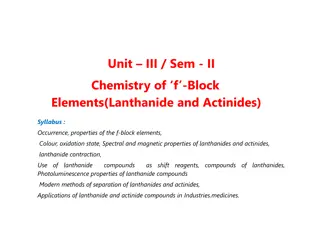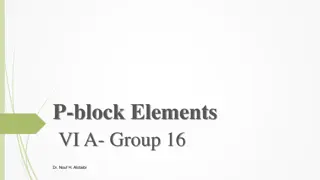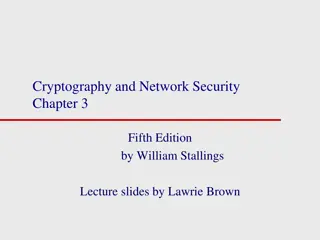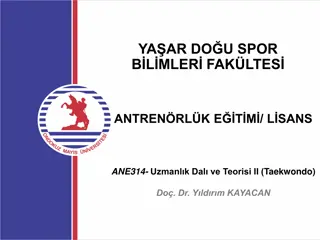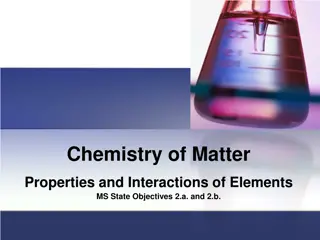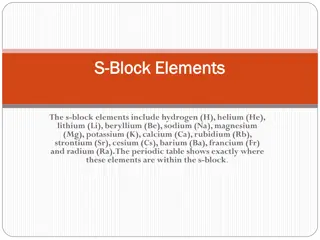D-Block Elements: Properties and Classification in Chemistry
Welcome to the Department of Chemistry at Kisan Veer Mahavidyalaya, Wai. Explore the Chemistry of Elements of the 3d series, focusing on d-Block Elements and Transition Elements. Learn about their electronic structure, colored ions, magnetic properties, oxidation states, and complex formation. Understand the significance of transition elements in bridging the properties of s-block and p-block elements. Discover the inner workings of main and inner transition elements, their electronic configurations, and their distinct physical and chemical properties. Dive into the fascinating world of transition elements and their role in the periodic table.
Download Presentation

Please find below an Image/Link to download the presentation.
The content on the website is provided AS IS for your information and personal use only. It may not be sold, licensed, or shared on other websites without obtaining consent from the author. Download presentation by click this link. If you encounter any issues during the download, it is possible that the publisher has removed the file from their server.
E N D
Presentation Transcript
WEL-COME Dr. D . N. Zambare Department of Chemistry , Kisan Veer Mahavidyalaya, Wai (Satara)
4.Chemistry of Elements of 3d series elements Contents 4.1 Introduction of d-Block Elements 4.2 Study of Transition Elements with respect to Electronic Structure, Coloured Ions, Magnetic Properties, Character, Oxidation States, and Complex Formation. --------------------------------------------------------------------- Those who aspire not to guess and Devine, but discover and know, who propose not to devise mimic and fabulous world of their own, but to examine and dissect the nature of this very world itself, must go to facts themselves for everything. F. Bacon (1620)
4.1 Introduction to d Block Elements The series of elements lying in between IIA and IIIA of the periodic table are collectively known as the d-block elements. They belong to groups 3 to 12 (the 1984 IUPAC recommendation) and are often called transition elements as they are positioned between the s and p block elements, in the middle of the periodic table. Their properties exhibit transition between highly reactive metallic elements of the s-block (which typically form ionic compounds) and the least metallic elements of the p-block (which form largely covalent compounds). The term transition elements was introduced originally by Mendeleeff to describe the three triads of elements belonging to VIII group of the periodic table viz. Fe, Co, Ni; Ru, Rh, Pd; Os, Ir and Pt. And today, the term transition elements has logically turned to be the useful means to designate these elements in the middle of the Long form of the Periodic Table (the Bohr s Periodic Table). For these elements, the penultimate shell of electrons is expanded from eight to eighteen i.e. (n-1) d1 ns2 to (n-1) d10 ns2 by the addition to the differentiating (last incoming) electron in the (n 1) d level, which is typically incompletely filled. Therefore, these elements are called d-block, d-type or simply d-elements.
Definition The elements which have partly filled d orbitals, in their atoms or ions, in any of their commonly occurring oxidation states are called the transition elements. Thus we treat the coinage metals Cu, Ag and Au as the transition metals since Cu2+, Ag2+ and Au2+ have 3d9, 4d9 and 5d8 configurations respectively. The terminal members in the d-block viz. Zn, Cd and Hg are characterized by the presence of completely filled d-orbitals (i.e. 3d10, 4d10 and 5d10 respectively). According to definition, these three elements are not to be regarded as the true transition elements. Due to this difference in their electronic configurations, Zn, Cd and Hg differ from rest of the transition elements in many physical and chemical properties. In general, based on the electronic structure, all the transition elements are classified into two broad classes. These are: 1. Main Transition Elements There are four series of main transition elements corresponding to the filling in 3d, 4d, 5d and 6d sub-levels. (See Fig. 4.1). 2. Inner (Sub) Transition Elements There are two series of sub or inner transition elements having partly filled d and f orbitals. For detailed information, refer Fig. 4.1. At present, out of the total number of elements known so far, about 60% are transition elements in the periodic table. In this chapter, we shall consider the characteristic properties of transition elements scandium to zinc belonging to the groups: (IIIB, IVB, VB VIB, VIIB, VIII, IB and IIB) i.e. 3 to 12 groups of the long form of the periodic table
Fig. 4.2: Position of 3d-series of transition elements in the long form of the periodic table General Properties For the transition elements, last two shells are incompletely filled. Elements have partly filled (n-1) shell i.e. d-sub shells. The elements are characterized by (n-1)dx ns2 configurations, where x = 1, 2, 3, 10. As the penultimate shell of all the transition elements is expanding their orbital architecture is much comparable. Therefore, they have many rich and interesting physical and chemical properties, in common.
1.2 Study of First Transition Series (1) Electronic Structure: Electronic structure is the fundamental basis of study of elemental chemistry. It may be regarded as a sketch-work of an element. Study of electronic configuration enables us to narrate the entire chemistry of the element. Meaning: By the term electronic structure we mean the study of distribution of electrons about the nucleus, in the available number of orbitals in accordance with the Aufbau principle. Aufbau order: In multi-electron atoms, the sequence of energy levels depends on the electron nuclear attraction, and also on electron-electron repulsion. Therefore the Aufbau order for elements from scandium (Z = 21) onwards would be 1s < 2s < 2p <3s <3p <4s <3d <4p <5s etc. General structure: The 3d-metals belong to the 4th period of the periodic table. The first member of this period is potassium K (Z = 19). Its electronic configuration is [Ar] 4s1, where argon, Ar (Z = 18) has electronic configuration 1s2, 2s2, 2p6, 3s2, 3p6. The next element, calcium, Ca (Z = 20) has configuration [Ar] 4s2 and from scadium, Sc (Z = 21) onwards, the addition of electrons should take place in 3d-level, in a regular way 3d1, 3d2, 3d3 3d10 with the exceptions of Cr and Cu. The general electronic configuration: for 3d series may be given as: (2), (8), (2, 6, x), (2) OR 1s2, 2s2, 2p6, 3s2, 3p6, 3dx 4s2where x = 1, 2, 3, 4 10 OR [Ar], 3dx 4s2, where x = 1, 2, 3 10. Table 4.1 gives the detailed electronic configurations of the first-row transition elements.
Table 4.1: The Electronic Configurations of the First Row Transition Elements Element Atomic number Scandium Titanium Vanadium Chromium Manganese Iron Cobalt Nickel Copper Zinc Symbol Electronic configuration [Ar], 3dx 4s2 (x = 1 to 10) 1s2, 2s2 2p6, 3s2 3p6, 3d1 4s2 21 22 23 24 25 26 27 28 29 30 Sc Ti V Cr Mn Fe Co Ni Cu (Zn) , 3d2 4s2 , 3d3 4s2 , 3d5 4s1 , 3d5 4s2 , 3d6 4s2 , 3d7 4s2 , 3d8 4s2 , 3d10 4s1 , 3d10 4s2
From Table 4.1 it should be noted that Chromium (Z = 24) and Copper (Z = 29) cause interruptions to the continuous build up., It is in accordance with the fact that when all the five 3d levels are either singly or doubly filled, a degree of special stability is conferred on the atom or ion. This explains why the electronic configurations of the chromium and copper are respectively 3d5 4s1 and 3d10 4s1. This observation will also explain why Fe2+(3d6) are easily oxidized to Fe3+(3d5) and why Mn2+ (3d5) are not readily oxidised to Mn3+ (3d4). The apparent anomaly of Cr and Cu may be further supported from the fact that the 3d and 4s sub-shells are very close in energy and at Cr there is actually a decrease in energy because of loss of electron-electron repulsion on breaking up the 4s2 pair. While in copper, the dropping of a 4s electron to the 3d does not lose electron-electron repulsion energy, but by this time the atomic number, i.e. the nuclear charge, increases so much that the 3d gets pulled lower than 4s. This is how one may account the related filling of d orbitals and the separate classification of the transition elements in the periodic table. See Fig. 4.1 and Table 4.1 and compare them with Fig. 4.3.
AE (20300 cm-1) (4 2g) (2) Coloured ions Origin of Colour: When white light falls on a substance, three types of interactions are encountered. 1. All the visible radiations may be completely reflected or transmitted. In such a case, the substance appears to be colourless or say white, e.g. chalk, milk etc. 2. The radiations may be completely absorbed; no light is reflected. In this case, the substance appears to be black, e.g. soot, coal, hairs, etc. 3. A part of the visible light is absorbed and the remaining is either reflected or transmitted (called complementary colour). This phenomenon causes the substance to be appear coloured, e.g. mango, apple, lion, flower, etc. are all with some specific colours. Thus, origin of the colour stems from the property of the substance to absorb certain radiant energy in the visible region of light (400 to 700 nm), (4 to 7 10 7 m). Complementary Colour: For every type of absorbed energy from visible region, there is a complementary colour that is transmitted. The colour of the substance is nothing but the colour of the transmitted light . Table 4.2 summarizes the relationship between colour absorbed and colour transmitted.
Table 4.2: Absorbed and Observed colours Coloured absorbed [Wavelength, nm] Ultra Violet Violet Blue Green Blue Blue Green Green Yellow Green Yellow Orange Red Near IR Radiations absorbed Colour observed < 380 380-435 435-480 480-490 490-500 500-560 560-580 580-595 595-650 650-750 > 750 Colourless Yellow Green Yellow Orange Red Purple Violet Blue Green Blue Blue Green Colourless Causes of Colouration in Transition Metals: The ionic and covalent compounds of 3d elements are usually coloured. The 'colour' of a transition metal ion is associated with: (a) The partially filled d orbitals, having electrons between 1 to 9. (b) The nature of the ligands surrounding the metal ion. (c) The number of ligands and the shape of the complex. (d) The presence of defects in the lattice. A complete theory of colour is very complex but it is put simply in terms of movement of electron from (I) one d orbital to other (d-d transition), (II) Ligand to metal (charge transfer).
(I) d-d Transition and Colouration: The 'colour' of transition metal compounds can best be explained on the basis of crystal field theory. We know that in transition metals, there are five d orbitals, which are oriented differently in space. In a free isolated gaseous ion, the five d orbitals are degenerate, that is, they are with same energy. But in real situation, the ion will be surrounded by 1. Solvent molecules, if it is in solution, 2. Other ligands, if it is in a complex, or 3. Other ions, if it is in a crystal lattice. Such surrounding groups affect the energy of some of the d-orbitals more than the others. Thus the d-orbitals are no longer degenerate, and they split into two groups of orbitals of different energies (called crystal field splitting). This may pictorially be represented for Ti3+ ion as in Fig. 4.4. Fig. 4.4: The splitting of the 3d orbitals of Ti3+ ion in an octahedral environment of water (ligands) in [Ti(H2O)6]3+ The transition metals have partially filled d orbitals and it is possible to promote electrons from one d level to another d level (d-d transition). The promotion corresponds to a fairly small energy difference, so that light is absorbed in the visible region, and the transition metal ion appears to be coloured due to complementary light (See Fig. 4.5).
Fig. 4.5: Ultra violet and visible absorption spectrum of [Ti(H2O)6]3+ Absorption Spectrum: that the absorption occurs at 500 nm or (20,300 cm 1) i.e. yellow- green radiations get absorbed and the light rich in blue and red radiations is given out. Hence [Ti(H2O)6]3+ appears violet. From UV-visible absorption spectrum of [Ti(H2O)6]3+, it is evident
The colour and number of 3d electrons present in some hydrated ions of transition metals are given in Table 4.3. Table 4.3: Colours of some transition metal ions Metal ion Electronic configuration Number of unpaired electrons 0 1 2 3 4 5 4 3 2 1 0 Colour [Sc(H2O)6]3+ [Ti(H2O)6]3+ [V(H2O)6]3+ [Cr(H2O)6]3+ [Mn(H2O)6]3+ [Fe(H2O)6]3+ [Fe(H2O)6]2+ [Co(H2O)6]2+ [Ni(H2O)6]2+ [Cu(H2O)6]2+ [Zn(H2O)6]2+ Particulars: (i) d0 d1 d2 d3 d4 d5 d6 d7 d8 d9 d10 Colourless Violet Green Violet Violet Yellow Green Pink Green Blue Colourless Sc3+ Zn2+ Note non-transitional since they have respectively 0 and 10, 3d electrons. Both of these are colourless e.g. Sc2O3 and ZnSO4. In these compounds, it is not possible to promote electrons within the d orbitals because in Sc3+ the d-level is empty, while in Zn2+, 3d orbitals are completely full. There is no vacant orbital in the d level. Hence electrons are to be promoted to next higher level, i.e. 4s or 4p. Such transition requires high amount of energy which is associated with UV light, where all the wavelengths of visible light are transmitted, therefore Cu+ and Zn2+ ions appear colourless. TiO2 (d0) is equally colourless, having zero electrons in 3d orbitals. that the hydrated and ions are
The ion [Cu(H2O)6]2+ with one unpaired electron (3d9) is blue because red light of appropriate energy is absorbed. On the other hand, [Co(H2O)6]2+ (3d7) having three unpaired electrons, absorbs light in blue-green region and appears red. In short, if the ionic species contain one or more unpaired electrons, they appear coloured. But if all the electrons are paired up the species appear white or colourless. (ii) The colour of transition metal ion has a marked effect depending upon the nature of ligands bonded to it. Frequently, the bonding occurs with either neutral molecule such as water or negative ions such as the chloride ions. Examples: (a) The hydrated copper (II) ion is pale blue. It changes to dark blue if sufficient ammonia is added and to green if sufficient chloride ions are added. The copper (II) chloride solution will be either blue or green, depending upon the relative concentrations of water molecules and chloride ions. [Cu(H2O)6]2+ (aq) + 4Cl [CuCl4]2 Pale blue (b) Similarly, hydrated cobalt (II) ions are pink but in the presence of sufficient chloride ions, a blue complex, [CoCl4]2 (aq), is formed. (c) The octahedral complex [Ni(NH3)6]2+ is blue, [Ni(H2O)6]2+ is green, while [Ni(NO)2]6]4 is brown red. (iii) By Planck equation: E = h , depending on the number of d electrons and frequency of radiation ( ), we may have the "d-d" transitions giving rise to several absorption bands, and therefore the corresponding colours to the transition metal ion. The actual colours of the ions may be varied by varying the existing conditions. Some illustrations have been listed in Table 4.4. (aq) + 6H2O Green
Table 4.4: Colours of Transition Metal Compounds Salts Colour Co-ordination compounds CrO KMnO4 Cr2O3 CrCl3 CrF3 K2CrO4 K2Cr2O7 Orange [Co(CN)6]3- (II) Charge Transfer and Colouration In the series Sc(III), Ti(IV), V(V), Cr(VI), and Mn(VII), ions have empty d orbitals, hence d-d spectra are not possible and hence these ions are expected to be colourless. However, they appear to be coloured, the 'colour' of these ions can be explained on the basis electron transfer from ligand to metal and formation of oxoions. Examples: (i) The MnO solution despite the d0 configuration of Mn, where Mn has oxidation state of (+7). Here colour of Mn is attributed to the charge transfer spectra. In MnO 4, an electron is momentarily transferred from O to Mn (Ligand e Metal). Thus O2 changes to O momentarily where Mn(VII) is reduced to Mn(VI). Charge transfer requires that energy levels on the two different atoms are fairly close. Charge transfer always produces intense colours. Solid KMnO4 is nearly black and MnO (ii) Compounds of Ti(IV), V(V), and Cr(VI) are coloured. This is attributed to the fact that as the oxidation number increases, higher states have increasing tendency for covalent bonding. Therefore, instead of simple highly charged ions, oxoions are formed and these are coloured e.g. TiO2+, VO3 are pale yellow. (iii) V2O5 where V is with 3d0 configuration is expected to be colourless but it is orange red. This is due to the presence of defects in the solid state. Colour Black Blackish Green Red-Violet Green Bright yellow [CrCl2(NH3)4]Cl [CrCl2(NH3)4]Cl [Co(NH3)6]3+ [Co(NH3)5. H2O]3+ [CoCl(NH3)5]2+ [Co(NO2)3(NH3)3] Violet (cis) Green (trans) Yellow-orange Pink Purple Yellow Violet 4 (from KMnO4) has an intense purple colour in 4 solution is dark purple. 4 CrO2 4 , etc.
(3) Magnetic properties (Character): Magnetic Behaviour: Different substances exhibit different behaviour when placed in the external magnetic field. Most of the substances are repelled by a strong magnetic field, while some are attracted by it. In a few cases, the force of attraction is found to be very large (e.g., iron, cobalt, nickel, magnetite (Fe3O4) and some Mn alloys). Such tendencies are called magnetic characters, or magnetic properties and the materials exhibiting these characters are called magnetic materials. The various kinds of magnetisms are Diamagnetism, Paramagnetism, Ferromagnetism and Antiferromagnetism. Substances showing these characters are called Diamagnetic, Paramagnetic, Ferromagnetic and Antiferromagnetic respectively (See Fig. 4.6)
Unit: Magnetons (BM). One BM is the magnetic moment thought by Bohr to be associated with the single electron in a hydrogen atom. In these units, a single 1s electron has a magnetic moment of 1.73 BM. The B, magnetic moment, expressed in units of Bohr Magnetons, is related to SI units as, B = h 4 = 9.274 10 24 JT 1 Where, h = Planck s constant (6.626 10 34 Js = constant = (3.1415926536) e = electronic charge (1.602 10 9 C) m = electron mass (9.110 10 31 kg) c = velocity of light (2.998 108 ms 1) JT 1 = S.I. units for , the magnetic moment. Magnetic moments are usually expressed in the units called Bohr 1 BM: Paramagnetism: the transition metals, where d orbitals are partially filled, paramagnetism is more likely. Transition metals in atomic, ionic and molecular states exhibit paramagnetism resulting from the presence of one or more unpaired electron spins. In few cases, special reinforcement of paramagnetism occurs as an effect of extensive co-operative electron-spin alignment; and this gives rise to Ferromagnetism, e.g. Fe, Co, Ni, Fe3O4, some alloys of Mn are ferromagnetism, can be, therefore, converted into permanent magnets. Because of electron spin, unpaired electrons give rise to paramagnetism. For
Theoretical Measurement: For the first row of transition metal ions, the magnetic moments are determined theoretically by the use of the general equation: (S + L) = 4S (S + 1) + L (L+ 1) B JT 1 where, S = Sum of the spin quantum numbers L = Sum of the orbital angular momentum quantum numbers B = 9.274 10 24 JT 1. For an electron, the spin quantum number has a value of 1 hence S = s.n, where n is the number of unpaired electrons present in the substance. In most of the compounds of first series of transition metal, the orbital contribution is quenched out because of the electrical fields of the surrounding atoms. With this view in mind, L 0, and we get the relation called spin only magnetic moment equation. i.e. (s) = 4S(S + 1) B (This gives magnetic moment in S.I. units of JT 1). By relating magnetic moment, , to number of unpaired electrons, n, we get the equation: (s) = n(n + 2) B S = s.n = n 2 The magnetic moment in Bohr Magnetons is given by (BM) = (s) B = 4S(S + 1) = (d) B = n(n + 2) If n = 1, (MB) = n(n + 2) = If n = 1, (MB) = n(n + 2) = 2, (JT 1 in S.I.) where, (Spin only formula) (Spin only formula) 1 (1 + 2) = 1.73 BM 2 (2 + 2) = 2.83 MB
Table 4.5: Magnetic Moments of 3d Transition Metals Metal ion Orbital Occupancy configuration of 3d orbitals Sc3+, Ti4+ Ti3+, V4+ V3+ Cr3+, V2+, Mn4+ Mn3, Cr2+ Fe3+, Mn2+ Co3+, Fe2+ Co2+ Ni2+ Cu2+ Zn2+, Cu+ d10 , , , , Unpaired electrons 0 1 2 3 4 5 4 3 2 1 0 Magnetic Moment (BM) Calculated 0.0 1.73 2.83 3.87 4.90 5.92 4.90 3.87 2.83 1.73 0.0 Experimental 0.0 1.7-1.8 2.8-3.1 3.7-3.9 4.80-4.90 5.7-6.0 5.0-5.6 4.3-5.2 2.9-3.9 1.9-2.1 0.0 3d0 d1 d2 d3 d4 d5 d6 d7 d8 d9 0 , , , , , , , , , , , , , , , , , , , , , , , , , , Fig. 4.8: Paramagnetism of Transition Metals (Graphical view) Illustrations: Transition metals consist of one or more partially filled d orbitals. If Hund's rule is obeyed, there is possibility for the presence of unpaired electrons, hence the paramagnetism. e.g. [CoF6]3
(4) Oxidation States Variable Valence (At the Outset): One of the most striking features of the transition elements is that they exist frequently in several different oxidation states. Furthermore, the elements exhibit a very wide range of oxidation states from 3 to +7 which change in units of one only. e.g. Cu+, Cu2+; Fe2+, Fe3+ etc. In this respect, transition elements differ from both s and p elements; where s block elements show a fixed oxidation state equal to their group number e.g. Na+, Mg2+ while p-block elements show oxidation state either equal to their group number or eight minus the group number. However, the p-block elements show variable oxidation states only to a limited extent and that also differing by units of two, e.g. PCl SnCl2 SnCl4, SO2 SO3, etc. Definition The term oxidation state may be defined as the charge that atom of the element bears or appears to bear in a compound . In other words, we may define oxidation state or oxidation number of a particular element as the formal charge that may be ascribed to each atom in a compound. Thus, we may consider oxidation number or oxidation state as the charge left on the central atom when all other atoms in the compound have been removed as their common ions. Oxidation state versus Valence: The term oxidation state or oxidation number is preferred to valency as it assumes nothing about the actual nature or the multiplicity of the bond. (i.e. whether bonding ionic or covalent or is single, double or triple). By valence or valency, we mean the combining capacity of the element. This is always a pure number, say 0, 2, 3 etc. 3 PCl5,
Calculations: The oxidation number can be calculated for both ionic and covalent compounds and without the knowledge of multiplicity of the bonds. For example, 1. The oxidation number of Cr in K2CrO4 can be calculated as follows: Remove 2K+ ions (which will leave two negative charges behind) and remove four O2 ions (leaving eight positive charges behind), so that the charge left on Cr is ( 2 + 8) = (+6). 2. Similarly, we can account (+7) and (+6) oxidation states of Mn respectively in KMnO4 and K2MnO4. It should be noted that the oxidation number is not essentially the charge on the ion. For example, Mn2+ can exist but Mn7+ or Mn6+ do
Trends: (a) both extremes (Sc3+ and Zn2+) to a maximum number of states in the middle (Mn 3 to +7). The details are as follows: (i) Scandium could have an oxidation state of (+2) if it s both 4s electrons are used for bonding. It shows (+3) state when two s and d electrons are involved in bonding. (ii) Titanium can have (+2) oxidation state when both s electrons are used for bonding, (+3) when two s and one d electrons are used and (+4) when all the four electrons, 3d2 4s2 from outer orbitals, are used for bonding. (iii) Similarly, vanadium exhibits (+2) to (+5) oxidation states. (iv) In the case of chromium, use of single electron from 4s gives us oxidation state of (+1) and then by using different numbers of d electrons, it can show oxidation states of (+2), (+3), (+4), (+5) and (+6). (v) Manganese can be accounted similarly and we may have its oxidation states (+2) to (+7). Thus, in all these cases, there is a perfect correlation between the electronic configuration and minimum and maximum oxidation states, especially in simple compounds. Consequently, the transition metals can show some similarities with elements of the main groups in oxidation states, to certain extent. For example, SO and CrO are isostructural, as are SiCl4 to and TiCl4 etc. Range of oxidation states There is a general trend between a minimum number of oxidation states at
(vi) In the succeeding elements, viz. Fe to Zn where the d5 configuration is exceeded, the tendency for all the d electrons to participate in bonding decreases. Thus, Fe has a maximum oxidation state of (+6), which is not related at all with its electronic configuration (3d6 4s2). (vii) But now there are claims for existence of FeO4 and if it is so, there will be a perfect harmony with electronic configuration and maximum oxidation state (+8) for Fe. (viii) It should be noted that the maximum oxidation states are obtained with increasing difficulty due to the increasing oxidizing power in the series. Hence stability of the maximum oxidation states decreases in the series that runs from scandium to zinc. i.e. Sc (+3) > Ti (+4) > V (+5) > Cr (+6) > Mn (+7) Fe (+8) Stability decreases where, Fe (+8) does not exist to appreciable extent. It is highly unstable. Now-a-days, there is an increasing researchers to prepare unusual oxidation states of the transition elements; so the above listing should not be considered as complete, (b) Particulars: (i) Only (+2) state of Sc and (+5) state of Co are, in doubt. (ii) Table 4.6 has several marked features. There is a peaking in the numerical value of the maximum state near the middle of the row, after which the maximum state gets smaller. This causes the oxidation states to build a regular pyramid in Table 14.6 which is rather convenient to memorize and to reproduce. (This type of table of oxidation state is only partially valid especially in case of higher series of transition elements.) (iii) Generally, the lower oxidation states are reducing and the higher oxidation states are oxidizing. e.g. Cr2+ is rapidly oxidized to Cr3+ in presence of air. Potassium dichromate, K2Cr2O7 which may (K+)2(Cr6+)2 (O2 )7, is a powerful oxidizing agent, gets easily reduced to Cr3+. tendency among be formally represented as
(iv) The lower oxidation states of transition metals give predominantly basic oxides and the predominantly acidic; while amphoteric. (See Table 4.7). Table 4.7: Oxides of Manganese Oxides of Manganese state oxide MnO Mn2O3 MnO2 MnO3 Mn2O7 +7 Acidic (v) The compounds in lower oxidation states are generally, ionic while compounds with maximum oxidation states are predominantly covalent, e.g. MnSO4 is ionic while KMnO4 i.e. MnO (vi) In general, lower oxidation states are more stable than the higher states for 3d series, e.g. For Fe, (+2) and (+3) are very stable while (+4) and (+5) are unstable and (+6) to (+7) are expected to be highly unstable. (vii) The stability of different oxidation states may be correlated to the electronic configurations and in turn to the special stabilities of d0, d5 and d10 configurations, i.e. completely empty, just half full and completely full configurations of d orbitals respectively. For example, Sc3+(d0) is more stable than Sc2+(d1); Ti4+(d0) is more stable than Ti3+(d1); Mn2+(d5) is more stable than M4+(d3); Fe3+(d5) is more stable than Fe2+(d6), etc. (viii) Further, it has been observed that with increase in oxidation state, there will be corresponding increase in acidity, ease of hydrolysis, solubility and crystallographic higher oxidation intermediate states oxides give are Oxidation Nature of Some Salts of Mn +2 +3 +4 +6 Basic Basic Mn(II) salts e.g. MnCl2 Few Mn(III) salts e.g. MnF3 Mn(SO4)2 and K2MnO3 K2MnO4 KMnO4 Amphoteric Acidic 4 is covalent.
(e) Review normal elements. Formation of complex ions is one such striking property of transition metals. This is in sharp contrast to the s and p block elements. Definition "A complex ion is one that contains a central ion (of transition metal) linked to other atoms, ions or molecules, called ligands". The ligands contain at least one lone-pair of electrons which is donated to the central metal ion during the formation of a complex. Thus, a complex is a combination of a Lewis acid (the transition metal) with a number of Lewis bases (the ligands). A ligand may be a neutral molecule such as NH3or an ion such as CN or Cl . Cobalt forms more complexes than any other element. For example: Fe3++ 6CN [Fe(CN)6]3 , Co3+ + 6NH3 [Co(NH3)6]3+ Fundamental Characteristics The chemistry of transition elements may be regarded as the chemistry of co-ordination compounds or the chemistry of complexes. The profuse ability to form complexes arises on account of the special properties associated with the transition metals. These properties are: 1. Transition metal ions have small ionic size. 2. They have comparatively high nuclear charge. 3. They are moderately basic. 4. They exhibit variable oxidation states. 5. Their electronic structure is rather suitable for bonding. 6. They are able to form and bonds with the ligands. 7. They have vacant or partially filled [n 1] d orbitals of suitable energy to accept lone pairs of electrons from the ligands to establish co-ordinate covalent bonds with them. Complex Formation: The transition metals have a much more diverse and interesting chemistry than those of the
is the subject matter of Valence Bond, Crystal Field, Molecular Orbital and Ligand Field theories, coming under co-ordination chemistry and chelation. Illustration For example, formation of [Co(NH3)6]3+ can be accounted according to VBT as follows: When Co3+ ion interacts with ligand environment (i.e. NH3), the rearrangement of metal ion electrons takes place so that the number of empty orbitals becomes equal to co-ordination number of metal ion (For Co3+, CN = 6). Co [Z = 27]: 2, 8, [2, 6, 7], 2 i.e. 1s2, 2s2 2p6, 3s2 3p6, 3d7 4s2, 4p0 The detailed study of structure and bonding for metal complexes
The empty orbitals thus formed, hybridize to produce equivalent number of hybrid orbitals with definite directional characteristics. The hybridization in Co3+ is d2sp3, and the geometry is octahedral. Finally filled orbitals of six NH3 ligands overlap with six empty hybrid orbitals of Co3+ ion to produce octahedral complex. In case of transition metal ion, whether inner d orbital (3d) or outer d' orbital (4d) is made available for hybridization solely depends upon the nature of ligands. If approaching ligand is weak (e.g. F , Cl ), it uses outer 4d orbitals for hybridization (i.e. sp3d2). The complex is called outer orbital complex. In present example, the ligand is strong, so inner '3d' orbitals are used for hybridization. Therefore [Co(NH3)6]3+ complex is inner orbital complex. Geometry is octahedral. The complex has no unpaired electrons, so it is diamagnetic.
Some typical complexes have been listed in Table 4.8, for the purpose of reference. Table 4.8: Metal ion complexes of 3d series Octahedral complexes (d2sp3/sp3d2) complexes (dsp2) Inner orbital (d2sp3) [Fe(CN)6]3 [Cr(NH3)6]3+ [Mn(CN)6]4+ Outer orbital (sp3d2) [FeF6]3 [Fe(H2O)6]3+ [Co(H2O)6]3+ [Ni(NH3)6]3+ [Ti(H2O)6]3+ Stability: If the ligands are easily displaced, the complex is said to be unstable and if they are difficult to remove, the complex is a stable one. Hydrated transition metal ions are normally the unstable complexes while anions such as CrO2 stable complexes. Formally, these complexes may be represented as Cr+6 (O2 )4 and Mn7+(O2 )4. Square planar Tetrahedral complexes (sp3) MnO CrO2 [Cu(CN)4]3 [Ni(CO)4] [NiCl4]2 [CuCl4]2 [Zn(NH3)4]2+ [Ni(CN)4]2- [Cu(NH3)4]2+ [Ni(NH3)4]2+ 4, MnO2 4 , Cr2O2 4 7 4 , MnO 4 are the
Catalytic Properties Most of the transition elements and their compounds exhibit catalytic properties. Some of the important ones are: TiCl4 Used as the Ziegler-Natta catalyst in the production of polythene. V2O5 For conversion of SO2 to SO2 in the manufacture of H2SO4 by contact process. MnO2 Catalyst for decomposition of KClO3 to manufacture O2. Fe Promoted iron is used in Haber process for the manufacture of NH3. FeCl3 Used in the production of CCl4 from CS2 and Cl2. Ni Raney nickel for number of reduction processes. Rappe synthesis (Polymerization of alkynes). (Complexes) Cu Manufacture of (CH3)2SiCl2 to get silicones. Cu/V Manufacture of Nylon-66. CuCl2 Deacon process to get Cl2 from HCl.
(D) Choose the correct alternative and rewrite the sentence: 1. Metals having partially filled orbitals are called transition elements. (a) d or f (c) f 2. The general outer electronic configuration of transition metal is (a) (n 1) d1-10ns1 (c) (n 1) d1-10 ns1-2 3. The metals which exhibit both vertical and horizontal similarities are elements. (a) representative (c) rare (d) transition 4. Transition elements belong to groups (a) 3 to 12 (c) 1 to 12 (b) d (d) d or s (b) (n 1) d10ns2 (d) (n 1) d5 ns2 (b) inert gas (b) 1 to 10 (d) 3 to 13 5. Variable valency is a general feature of elements (a) d-block (c) p-block 6. The first row transition elements (3d series) comprise of ten elements from (a) Sc (21) to Zn (30) (c) Sc (21) to Cu (29) (d) Ti (22) to Ga (31) 7. The electronic configuration of Zn2+ ion is (a) [Ai] 3d10 4s2 (b) [Ar] 3d10 4s0 (c) [Ad] 3d8 4s2 (b) s-block (d) all (b) Ca (20) to Cu (29) (d) [Ar] 3d9 4s1
8. All ionic and covalent compounds of 3d elements are coloured, the 'colour' of a compound is due to (a) d-d transition only (b) d-d transition and charge transfer phenomena (c) charge transfer only (d) colour of ligands 9. [Ti(H2O)6]3+ absorbs yellow-green radiations, it appears to be coloured. (a) violet (b) blue (c) green (d) colourless 10. Which ion gives coloured solution? (a) Cu+ (b) Zn2+ (c) Ag+ (d) Fe2+ 11. The substances that are repelled by external strong magnetic field are called substances. (a) diamagnetic (b) paramagnetic (c) ferromagnetic (d) magnetic 12. Paramagnetism is a property of (a) completely filled electronic subshell (b) unpaired electron (c) 'd' electron (d) non-transition elements 13. Magnetic moments are expressed in the units called (a) Bohr magnetrons (BM) (b) Tesla (c) Guass (d) JT 1 14. The highest magnetic moment for transition metals exists for (a) Ti3+ (d1) (b) Cr3+ (d3) (c) Mn2+ (d5) (d) Cu2+ (d9) 15. Ni2+ ion is (a) diamagnetic (b) paramagnetic (c) colourless (d) ferromagnetic 16. [CoF6]3 is while [Co(NH3)6]3+ is (a) paramagnetic, diamagnetic (b) diamagnetic, paramagnetic (c) ferromagnetic, antiferromagnetic (d) magnetic, non-magnetic 17. The highest oxidation number is shown by element.





